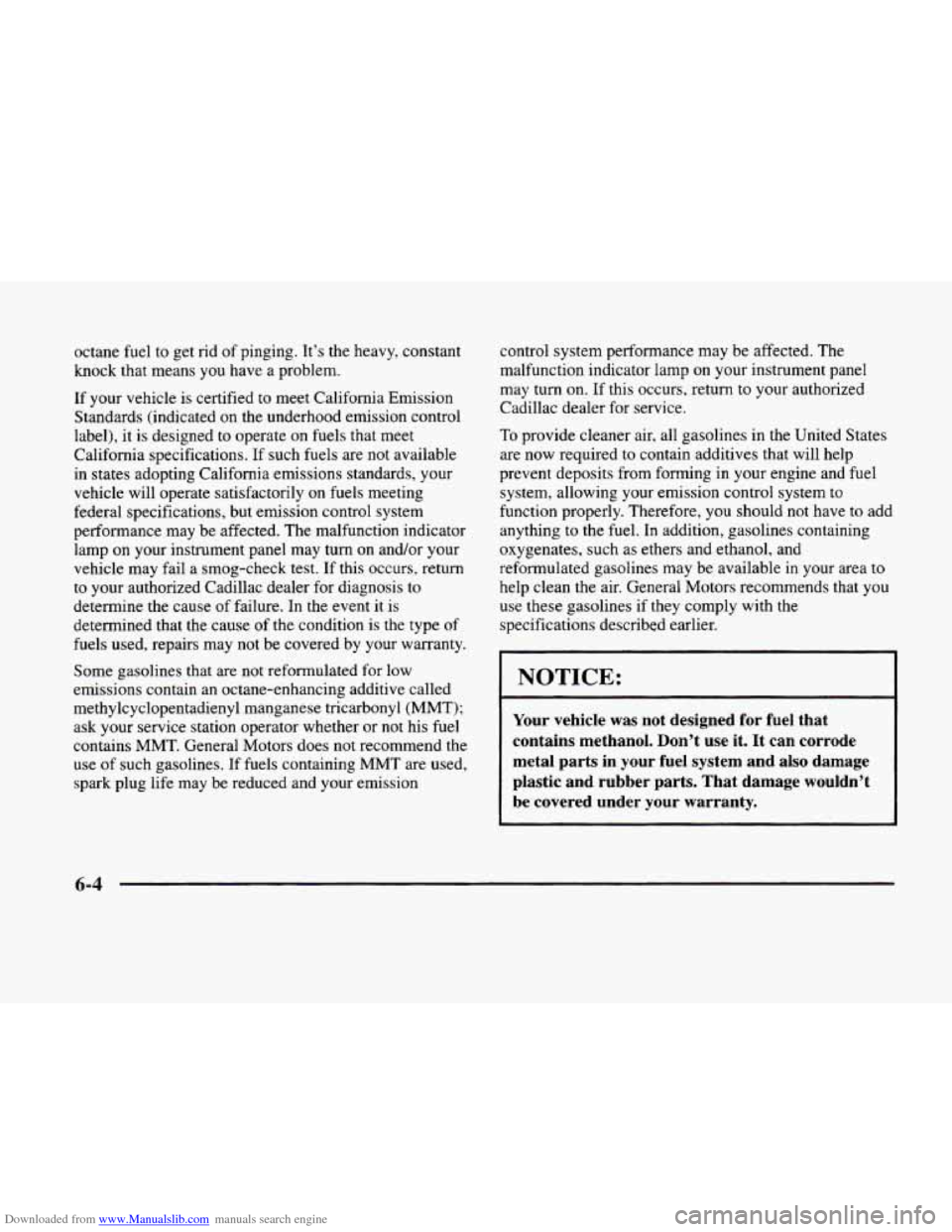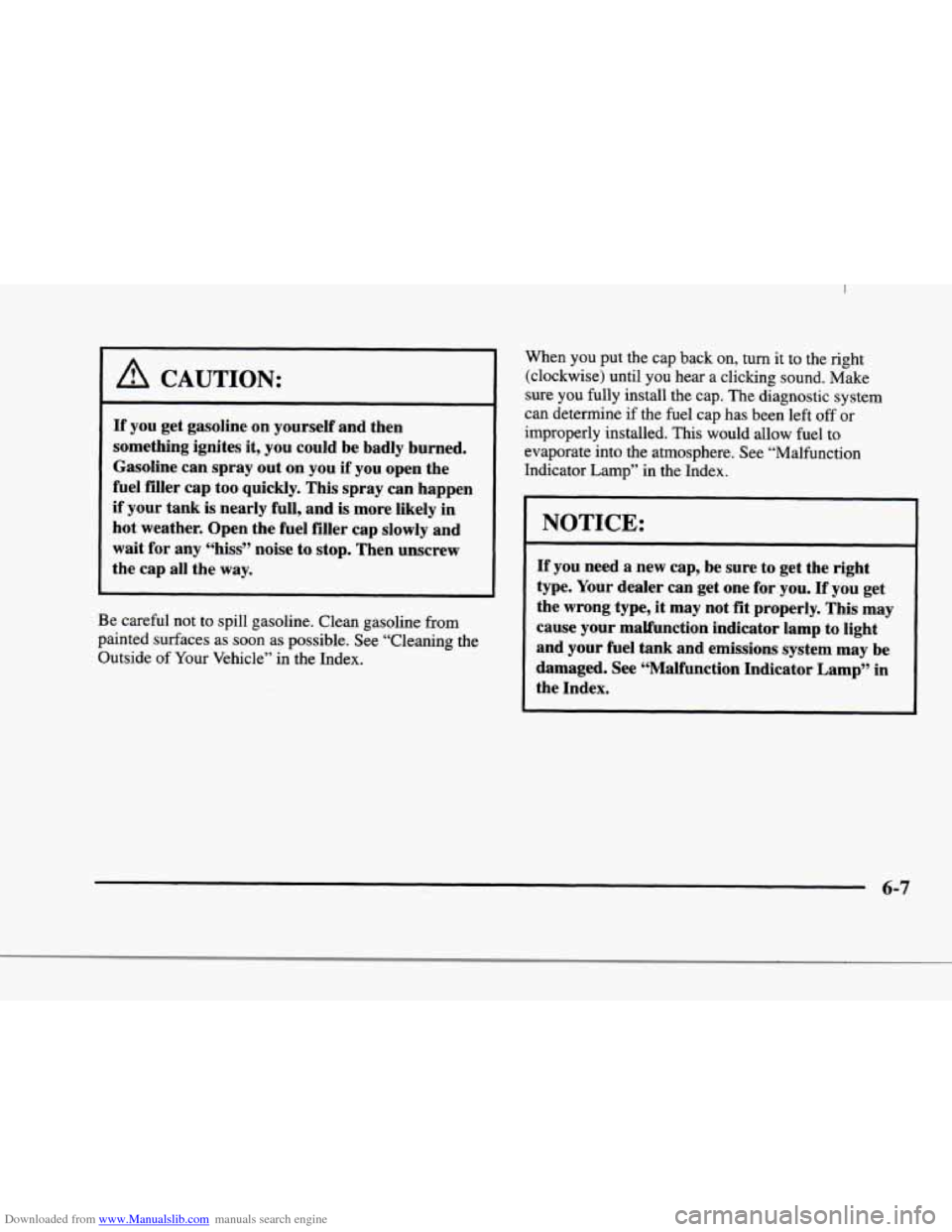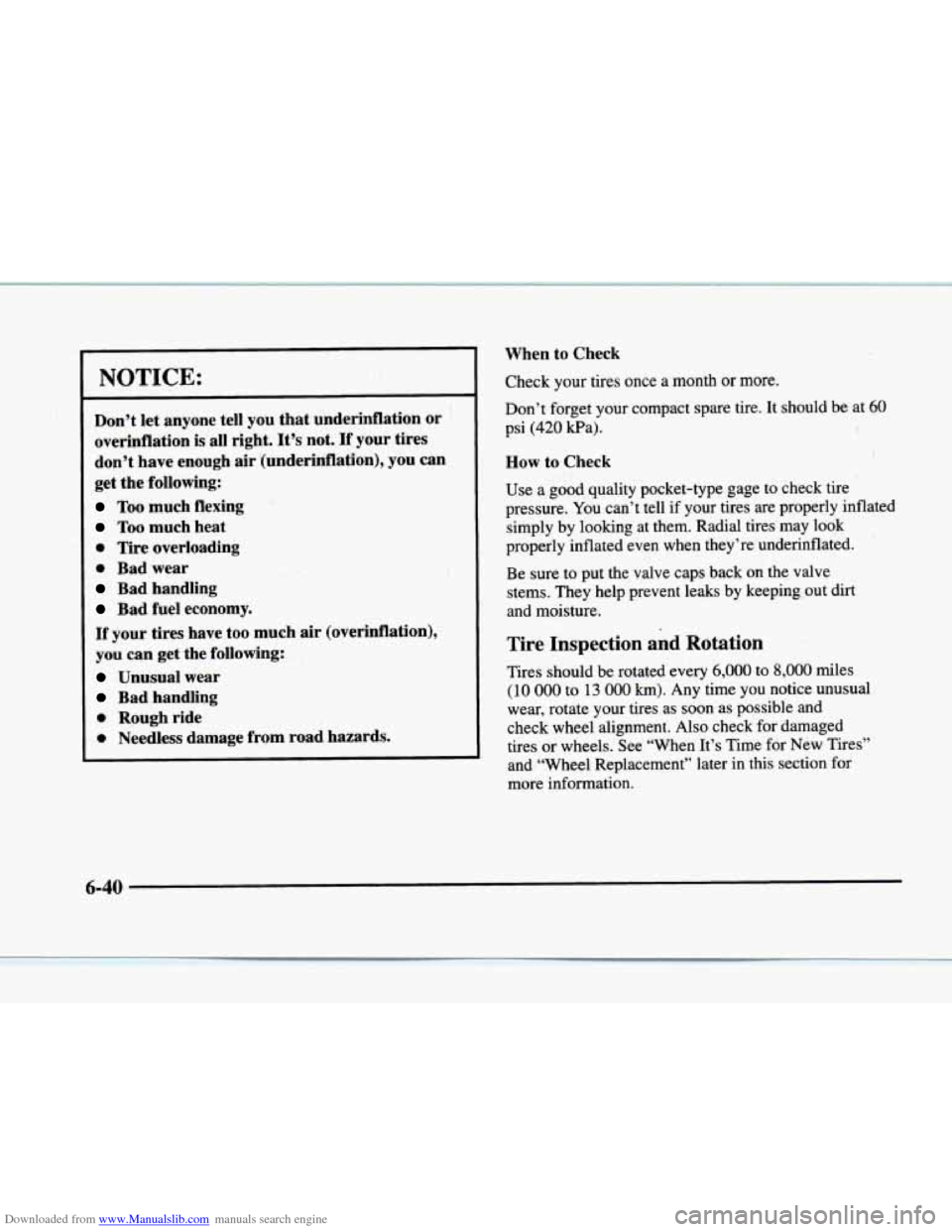1998 CADILLAC ELDORADO fuel type
[x] Cancel search: fuel typePage 284 of 380

Downloaded from www.Manualslib.com manuals search engine octane fuel to get rid of pinging. It’s the heavy, constant
knock that means you have a problem.
If your vehicle is certified to meet California Emission
Standards (indicated
on the underhood emission control
label), it
is designed to operate on fuels that meet
California specifications. If such fuels are not available
in states adopting California emissions standards, your
vehicle will operate satisfactorily
on fuels meeting
federal specifications, but emission control system
performance may be affected. The malfunction indicator
lamp
on your instrument panel may turn on and/or your
vehicle may fail a smog-check test. If this occurs, return
to your authorized Cadillac dealer for diagnosis to
determine the cause of failure. In the event it is
determined that the cause
of the condition is the type of
fuels used, repairs may not be covered by your warranty.
Some gasolines that are not reformulated for low
emissions contain an octane-enhancing additive called
methylcyclopentadienyl manganese tricarbonyl
(MMT);
ask your service station operator whether or not his fuel
contains
MMT. General Motors does not recommend the
use of such gasolines.
If fuels containing MMT are used,
spark plug life
may be reduced and your emission control system
performance may be affected. The
malfunction indicator lamp
on your instrument panel
may turn on. If this occurs, return to your authorized
Cadillac dealer for service.
To provide cleaner air, all gasolines in the United States
are now required to contain additives that will help
prevent deposits from forming in your engine and fuel
system, allowing your emission control system to
function properly. Therefore,
you should not have to add
anything to the fuel. In addition, gasolines containing
oxygenates, such as ethers and ethanol, and
reformulated gasolines may be available in your area to
help clean the air. General Motors recommends that
you
use these gasolines if they comply with the
specifications described earlier.
I NOTICE:
Your vehicle was not designed for fuel that
contains methanol. Don’t use it. It
can corrode
metal parts in your fuel system and also damage
plastic and rubber parts. That damage wouldn’t
be covered under your warranty.
6-4
Page 287 of 380

Downloaded from www.Manualslib.com manuals search engine r
r
r-
f
I
f
1
I“
I
1 A CAUTION:
If you get gasoline on yourself and then
something ignites it, you could be badly burned.
Gasoline can spray out on you if you open the
fuel filler cap too quickly. This spray can happen
if your
tank is nearly full, and is more likely in
hot weather. Open the fuel filler cap slowly
and
wait for any “hiss” noise to stop. Then unscrew
the cap all the way.
Be careful not to spill gasoline. Clean gasoline from
painted surfaces as soon as possible. See “Cleaning the
Outside of Your Vehicle” in the Index. When
you put
the cap back on, turn it to the right
(clockwise) until you hear a clicking sound. Make
sure you
fully install the cap. The diagnostic system
can determine if the fuel cap has been left
off or
improperly installed. This would allow fuel to
evaporate into the atmosphere. See “Malfunction
Indicator Lamp” in the Index.
NOTICE:
If you need a new cap, be sure to get the right
type. Your dealer can get one for you.
If you get
the wrong type, it may not fit properly. This may
cause your malfunction indicator lamp
to light
and your fuel
tank and emissions system may be
damaged.
See “Malfunction Indicator Lamp” in
the Index.
6-7
Page 320 of 380

Downloaded from www.Manualslib.com manuals search engine NOTICE:
Don’t let anyone tell you that underinflation or
overinflation
is all right. It’s not. If your tires
don’t have enough air (underinflation), you can
get
the following:
Too much flexing
Too much heat
0 Tire overloading
0 Bad wear
Bad handling
Bad fuel economy.
If your tires have too much air (overinflation),
you can get the following:
Unusual wear
Bad handling
0 Rough ride
0 Needless damage from road hazards. When
to Check
Check your tires once a month or more.
Don’t forget your compact spare tire. It should be at
60
psi (420 Wa).
How to Check
Use a good quality pocket-type gage to check tire
pressure.
You can’t tell if your tires are properly inflated
simply by looking
at them. Radial tires may look
properly inflated even when they’re underinflated.
Be sure to put the valve caps back on the valve
stems. They help prevent leaks by keeping out dirt
and moisture.
Tire Inspection and Rotation
Tires should be rotated every 6,000 to 8,000 miles
( 10 000 to 13 000 km). Any time you notice unusual
wear, rotate your tires as soon as possible and
check wheel alignment. Also check for damaged
tires or wheels. See “When It’s Time for New Tires”
and “Wheel Replacement” later in this section for
more information.
a
Page 344 of 380

Downloaded from www.Manualslib.com manuals search engine Replacement Bulbs
Application Number
Headlamps Composite Inner High Beam
....................... 9005
Outer Low Beam ....................... 9006
Front Turn Signal ..................... 2357 NA
Center High-Mounted Stoplamp (CHMSL) ... 1156
Rear Turn Signal and Taillamp ............. 2057
Capacities and Specifications
Displacement ......... 279 cubic inches (4 565 cc)
Engine Specifications
Type .......................... 4.6L DOHC V8
Eldorado ............................... Y
ETC .................................. 9
VIN Engine Code
Horsepower Eldorado
.............. 275 (bhp) @ 5600 rpm
ETC ................. 300 (bhp) @ 6000 rpm
205 (kWj @ 5600 rprn
224 (kWj @ 6000 rpm Torque
Eldorado
............. 300 (lb-ft) @ 4000 rpm
ETC ................ 295 (lb-ft) @ 4400 rpm
Firing Order
................... 1-2-7-3-4-5-6-8
407
(N-m)
@ 4000 rpm
400 (N-m) @ 4400 rpm
Thermostat Starts
To Open . . 177-184°F (81-85°C)
Capacities
Crankcase (Engine Oil
Transaxle (4T80-E) .......... 15 quarts (14.2 Lj
with Filter Change) ........... 7.5 quarts (7.1 L)
Engine Cooling System
........ 12.5 quarts ( 1 1.8 L)
R- 134a Refrigerant .............. 2 lbs. (0.91 kg)
Wheel Base
............... 108 inches (274.3 cm)
Length
................. 200.2 inches (508.6 cm)
Height
................... 53.6 inches ( 136.2 cm)
Fuel Tank
....... : ........... 20 gallons
(75.7 L)
Vehicle Dimensions
Width ................... 75.5 inches (191.8 cmj
Front Tread
............... 60.9 inches (154.7 cm)
6-64
Page 345 of 380

Downloaded from www.Manualslib.com manuals search engine Rear Tread ........................ 60.9 inches
(154.7 cm)
Wheel Nut Torque ................... 100 lb-ft
(140 N-m)
Air Conditioning Refrigerants
Not all air conditioning refrigerants are the same.
If the air conditioning system in your vehicle needs
refrigerant, be sure the proper refrigerant is used.
If
you’re not sure, ask your dealer.
Normal Maintenance
Replacement Parts
Air Filter Element ............. AC Type A 1096C
Fuel Filter Element
............ AC Type GF-580
Engine Oil Filter ................ AC Type PF-58
PCV Valve .................. AC Type CV-774C
Spark Plugs
................... AC Type 41 -900
Thermostat .................... AC Type 13 1-66
Windshield Wiper Blade (Pin Type)
................ .22 inches (56.5 ern)
6-65